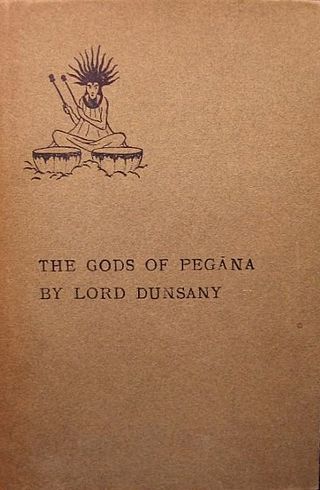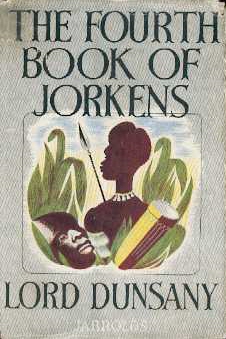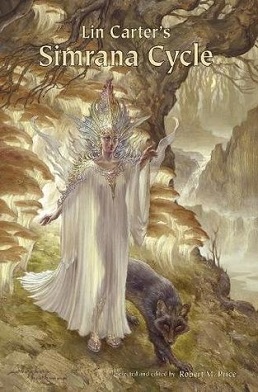Related Research Articles

Edward John Moreton Drax Plunkett, 18th Baron of Dunsany,, commonly known as Lord Dunsany, was an Anglo-Irish writer and dramatist. He published more than 90 books during his lifetime, and his output consisted of hundreds of short stories, plays, novels, and essays. He gained a name in the 1910s as a great writer in the English-speaking world. Best known today are the 1924 fantasy novel, The King of Elfland's Daughter, and his first book, The Gods of Pegāna, which depicts a fictional pantheon. Many critics feel his early work laid grounds for the fantasy genre.

Sword and sorcery (S&S) or heroic fantasy is a subgenre of fantasy characterized by sword-wielding heroes engaged in exciting and violent adventures. Elements of romance, magic, and the supernatural are also often present. Unlike works of high fantasy, the tales, though dramatic, focus on personal battles rather than world-endangering matters. Sword and sorcery commonly overlaps with heroic fantasy. The genre originated from the early-1930s works of Robert E. Howard. The term "sword and sorcery" was coined by Fritz Leiber In the May 1961 issue of the fantasy fanzine Amra, to describe Howard and the stories that were influenced by his works. In parallel with "sword and sorcery", the term "heroic fantasy" is used, although it is a more loosely defined genre.

A Fantasy trope is a specific type of literary tropes that occurs in fantasy fiction. Worldbuilding, plot, and characterization have many common conventions, many of them having ultimately originated in myth and folklore. J. R. R. Tolkien's legendarium for example, was inspired from a variety of different sources including Germanic, Finnish, Greek, Celtic and Slavic myths. Literary fantasy works operate using these tropes, while others use them in a revisionist manner, making the tropes over for various reasons such as for comic effect, and to create something fresh.

The Dream-Quest of Unknown Kadath is a novella by American writer H. P. Lovecraft. Begun probably in the autumn of 1926, the draft was completed on January 22, 1927 and it remained unrevised and unpublished in his lifetime. It is both the longest of the stories that make up his Dream Cycle and the longest Lovecraft work to feature protagonist Randolph Carter. Along with his 1927 novel The Case of Charles Dexter Ward, it can be considered one of the significant achievements of that period of Lovecraft's writing. The Dream-Quest combines elements of horror and fantasy into an epic tale that illustrates the scope and wonder of humankind's ability to dream.

The Gods of Pegāna is the first book by Anglo-Irish writer Lord Dunsany, published in 1905. The fantasy book was reviewed favourably but as an unusual piece. One of the more influential reviews was by Edward Thomas in the London Daily Chronicle.

The Fantastic Swordsmen is a 1967 anthology of fantasy short stories in the sword and sorcery subgenre, edited by American writer L. Sprague de Camp. It was first published in paperback by Pyramid Books. It was the third such anthology assembled by de Camp, following his earlier Swords and Sorcery (1963) and The Spell of Seven (1965). It has also been translated into German.

The Fourth Book of Jorkens is a collection of fantasy short stories, narrated by Mr. Joseph Jorkens, by writer Lord Dunsany. It was first published by Jarrolds in 1947. It was the fourth collection of Dunsany's Jorkens tales to be published. It has also been issued in combination with the third book, Jorkens Has a Large Whiskey, and two uncollected short stories, in the omnibus edition The Collected Jorkens, Volume Two, published by Night Shade Books in 2004.

At the Edge of the World is a collection of fantasy short stories by Irish writer Lord Dunsany, edited by Lin Carter. It was first published in paperback by Ballantine Books as the thirteenth volume of its Ballantine Adult Fantasy series in March 1970. It was the series' second Dunsany volume, and the first collection of his shorter fantasies assembled by Carter.

Over the Hills and Far Away is a collection of fantasy short stories by Lord Dunsany, edited by Lin Carter. It was first published in paperback by Ballantine Books as the sixty-fifth volume of its celebrated Ballantine Adult Fantasy series in April 1974. It was the series' sixth Dunsany volume, and the third collection of his shorter fantasies assembled by Carter.

Beyond the Fields We Know is a collection of fantasy short stories by Irish writer Lord Dunsany, and edited by Lin Carter. The title is derived from a description of the location of the border of Elfland used over one hundred times in Lord Dunsany's best-known novel, The King of Elfland's Daughter. It was first published in paperback by Ballantine Books as the forty-seventh volume of its Ballantine Adult Fantasy series in May 1972. It was the series' fourth Dunsany volume, and the second collection of his shorter fantasies assembled by Carter.

Time and the Gods is the second book by Irish fantasy writer Lord Dunsany, considered a major influence on the work of J. R. R. Tolkien, H. P. Lovecraft, Ursula K. Le Guin, and others. It is a collection of short stories linked by Dunsany's invented pantheon of deities who dwell in Pegāna. It was preceded by his earlier collection The Gods of Pegāna and followed by some stories in The Sword of Welleran and Other Stories. Dunsany included a brief preface in the original edition and added a new introduction to the 1922 edition.

The Sword of Welleran and Other Stories is the third book by Anglo-Irish fantasy writer Lord Dunsany, considered a major influence on the work of J. R. R. Tolkien, H. P. Lovecraft, Ursula K. Le Guin, and others. It was first published in hardcover by George Allen & Sons in October 1908, and has been reprinted a number of times since. Issued by the Modern Library in a combined edition with A Dreamer's Tales as A Dreamer's Tales and Other Stories in 1917.

A Dreamer's Tales is the fourth book by Irish fantasy writer Lord Dunsany, considered a major influence on the work of J. R. R. Tolkien, H. P. Lovecraft, Ursula K. Le Guin, and others. Like most of Dunsany's early books, A Dreamer's Tales is a collection of fantasy short stories.
The Book of Wonder is the seventh book and fifth original short story collection of Irish fantasy writer Lord Dunsany, considered a major influence on the work of J. R. R. Tolkien, H. P. Lovecraft, Ursula K. Le Guin, and others. It was first published in hardcover by William Heinemann in November 1912, and has been reprinted a number of times since. A 1918 edition from the Modern Library was actually a combined edition with Time and the Gods.

The Last Book of Wonder, originally published as Tales of Wonder, is the tenth book and sixth original short story collection of Irish fantasy writer Lord Dunsany, considered a major influence on the work of J. R. R. Tolkien, H. P. Lovecraft, Ursula K. Le Guin and others.

In the Land of Time and Other Fantasy Tales is a posthumous collection of short stories by the writer Lord Dunsany in the Penguin Classics series. Edited and with an introduction by S. T. Joshi, it assembles material from across Dunsany's long career. The cover illustration is a colourised version of a classic illustration for an early Dunsany story by his preferred artist, Sidney Sime.

Time and the Gods is an omnibus collection of fantasy stories by Anglo-Irish writer Lord Dunsany. It was first published by Orion Books in 2000 as the second volume of their Fantasy Masterworks series. This omnibus contains all the stories from Dunsany's earlier collections: The Gods of Pegāna (1905), Time and the Gods (1906), The Sword of Welleran and Other Stories (1908), A Dreamer's Tales (1910), The Book of Wonder (1912), and The Last Book of Wonder (1916).

Lin Carter's Simrana Cycle is a collection of fantasy short stories by American writer Lin Carter, selected and edited by Robert M. Price. It was first published in hardcover, trade paperback and ebook by Celaeno Press in February 2018.
References
- 1 2 3 4 5 6 7 Rateliff, John D. (30 November 1990). "1 iii". "'Beyond the fields we know': the short stories of Lord Dunsany" (Thesis). Marquette University. pp. 49–57.
- 1 2 3 Schweizer, Darrell (1989). Pathways to Elfland: The Writings of Lord Dunsany. Wildside Press. pp. 13–15. ISBN 9781587151330. Archived from the original on 14 August 2023. Retrieved 31 July 2023.
- 1 2 3 Anderson, Angelee Sailer (1988). "Lord Dunsany: The Potency of Words and The Wonder of Things". Mythlore . 15 (2). Archived from the original on 31 July 2023. Retrieved 31 July 2023.
- 1 2 Joshi, S. T.; Schweitzer, Darrell, eds. (2013). Lord Dunsany: A Comprehensive Bibliography. Scarecrow Press. p. 12. ISBN 9780810893146. Archived from the original on 14 August 2023. Retrieved 3 August 2023.
- 1 2 Clute, John (1997). "Dunsany, Lord". In Clute, John; Grant, John (eds.). The Encyclopedia of Fantasy. London: Orbit. Retrieved 3 August 2023.
- ↑ Dunsany, Lord (1910). The Fortress Unvanquishable, Save for Sacnoth. Illustrated by William F. Northend. Sheffield, UK: William F. Northend at the School of Art Press.
- ↑ Foster, John Wilson (1993). Fictions of the Irish Literary Revival: A Changeling Art. Syracuse University Press. p. 296. ISBN 9780815625889. Archived from the original on 14 August 2023. Retrieved 31 July 2023.
- ↑ Landow, George P. (Spring 1979). "And the World Became Strange: Realms of Literary Fantasy". The Georgia Review. 33 (1): 7–42. JSTOR 41397679. Archived from the original on 31 July 2023. Retrieved 31 July 2023.
- ↑ Joshi, S. T. (2004). "Introduction". In the Land of Time and Other Fantasy Tales by Lord Dunsany. Penguin. Retrieved 7 September 2023.
- ↑ Tompkins, Steve (2010). "After Aquilonia, and having left Lankhmar...: Sword-and-Sorcery Since the 1980s". In Schweitzer, Darrell (ed.). The Robert E. Howard Reader. Wildside Press. p. 179. ISBN 9781434411655. Archived from the original on 31 July 2023. Retrieved 31 July 2023.